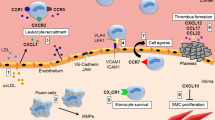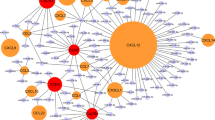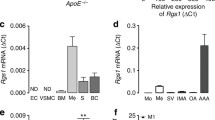Abstract
Recruitment of mononuclear leukocytes and the migration, growth, and activation of the multiple cell types within atherosclerotic lesions are critical features of the chronic inflammatory and fibroproliferative response central to atherosclerosis. Attraction of leukocyte to tissues is controlled by chemokines, whose presence is well documented in atherosclerotic lesions. Studies using knockout and transgenic murine models have demonstrated that chemokine receptor/ligand interactions are of crucial importance in the development of atherosclerosis. Beyond their chemotactic effect on mononuclear leukocytes, chemokines may also interfere with smooth muscle cell migration and growth, as well as platelet activation and other well-defined features of the atherosclerotic process. There is no doubt that the identification of chemokines as important vascular signals has provided insights into our understanding of basic cellular and molecular mechanism of atherosclerosis. Thus, there is evidence that chemokine receptor/ligands could be identified as potential new targets for therapeutic intervention to prevent or control atherosclerosis in the near future.
Similar content being viewed by others
References and Recommended Reading
Lopez AD, Murray CC: The global burden of disease, 1990–2020. Nat Med 1998, 4:1241–1243.
Libby P, Sukhova G, Lee RT, Liao JK: Molecular biology of atherosclerosis. Int J Cardiol 1997, 62(suppl 2):S23–29.
Hansson GK: Inflammation and immune response in atherosclerosis. Curr Atheroscler Rep 1999, 1:150–155.
Ross R: Atherosclerosis-an inflammatory disease. N Engl J Med 1999, 340:115–126.
Libby P: Changing concepts of atherogenesis. J Intern Med 2000, 247:349–358.
Terkeltaub R, Boisvert WA, Curtiss LK: Chemokines and atherosclerosis. Curr Opin Lipidol 1998, 9:397–405.
Reape TJ, Groot PH: Chemokines and atherosclerosis. Atherosclerosis 1999, 147:213–225.
Gerszten RE, Mach F, Sauty A, et al.: Chemokines, leukocytes, and atherosclerosis. J Lab Clin Med 2000, 136:87–92.
Moreno PR, Falk E, Palacios IF, et al.: Macrophage infiltration in acute coronary syndromes. Implications for plaque rupture. Circulation 1994, 90:775–778.
Stemme S, Holm J, Hansson GK: T lymphocytes in human atherosclerotic plaques are memory cells expressing CD45RO and the integrin VLA-1. Arterioscler Thromb 1992, 12:206–211.
Hansson GK, Holm J, Jonasson L: Detection of activated T lymphocytes in the human atherosclerotic plaque. Am J Pathol 1989, 135:169–175.
Springer TA: Traffic signals for lymphocyte recirculation and leukocyte emigration: the multistep paradigm. Cell 1994, 76:301–314.
Luster AD: Chemokines-chemotactic cytokines that mediate inflammation. N Engl J Med 1998, 338:436–345.
Baggiolini M, Dewald B, Moser B: Human chemokines: an update. Annual Rev Immunol 1997, 15:675–705.
Baggiolini M: Chemokines and leukocyte traffic. Nature 1998, 392:565–568.
Breslow JL: Transgenic mouse models of lipoprotein metabolism and atherosclerosis. Proc Natl Acad Sci USA 1993, 90:8314–8318.
De Villiers WJ, Smith JD, Miyata M, et al.: Macrophage phenotype in mice deficient in both macrophage-colony-stimulating factor (op) and apolipoprotein E. Arterioscler Thromb Vasc Biol 1998, 18:631–640.
Qiao JH, Tripathi J, Mishra NK, et al.: Role of macrophage colony-stimulating factor in atherosclerosis: studies of osteopetrotic mice. Am J Pathol 1997, 150:1687–1699.
Dansky HM, Charlton SA, Harper MM, Smith JD: T and B lymphocytes play a minor role in atherosclerotic plaque formation in the apolipoprotein E-deficient mouse. Proc Natl Acad Sci U S A 1997, 94:4642–4646.
Kovanen PT, Kaartinen M, Paavonen T: Infiltrates of activated mast cells at the site of coronary atheromatous erosion or rupture in myocardial infarction. Circulation 1995, 92:1084–1088.
Kaartinen M, Penttila A, Kovanen PT: Accumulation of activated mast cells in the shoulder region of human coronary atheroma, the predilection site of atheromatous rupture. Circulation 1994, 90:1669–1678.
Pentikainen MO, Lehtonen EM, et al.: Human arterial proteoglycans increase the rate of proteolytic fusion of low density lipoprotein particles. J Biol Chem 1997, 272:25283–25288.
Mach F, Schonbeck U, Sukhova GK, et al.: Functional CD40 ligand is expressed on human vascular endothelial cells, smooth muscle cells, and macrophages: implications for CD40-CD40 ligand signaling in atherosclerosis. Proc Natl Acad Sci U S A 1997, 94:1931–1936.
Lutgens E, Gorelik L, Daemen MJ, et al.: Requirement for CD154 in the progression of atherosclerosis. Nat Med 1999, 5:1313–1316.
Mach F, Schonbeck U, Libby P: CD40 signaling in vascular cells: a key role in atherosclerosis? Atherosclerosis 1998, 137(suppl):S89–95.
Schonbeck U, Mach F, Libby P: CD154 (CD40 ligand). Int J Biochem Cell Biol 2000, 32:687–693.
Mach F, Schonbeck U, Sukhova GK, et al.: Reduction of atherosclerosis in mice by inhibition of CD40 signaling. Nature 1998, 394:200–203.
Schonbeck U, Sukhova GK, Shimizu K, et al.: Inhibition of CD40 signaling limits evolution of established atherosclerosis in mice. Proc Natl Acad Sci U S A 2000, 97:7458–7463.
Gerszten RE, Garcia-Zepeda EA, Lim YC, et al.: MCP-1 and IL-8 trigger firm adhesion of monocytes to vascular endothelium under flow conditions. Nature 1999, 398:718–723.
Nelken NA, Coughlin SR, Gordon D, Wilcox JN: Monocyte chemoattractant protein-1 in human atheromatous plaques. J Clin Invest 1991, 88:1121–1127.
Ylä-Herttuala S, Lipton BA, Rosenfeld ME, et al.: Expression of monocyte chemoattractant protein 1 in macrophagerich areas of human and rabbit atherosclerotic lesions. Proc Natl Acad Sci U S A 1991, 88:5252–5256.
Yu X, Dluz S, Graves DT, et al.: Elevated expression of monocyte chemoattractant protein 1 by vascular smooth muscle cells in hypercholesterolemic primates. Proc Natl Acad Sci U S A 1992, 89:6953–6957.
Berkhout TA, Sarau HM, Moores K, et al.: Cloning, in vitro expression, and functional characterization of a novel human CC chemokine of the monocyte chemotactic protein (MCP) family (MCP-4) that binds and signals through the CC chemokine receptor 2B. J Biol Chem 1997, 272:16404–16413.
Wilcox JN, Nelken NA, Coughlin SR, et al.: Local expression of inflammatory cytokines in human atherosclerotic plaques. J Atheroscler Thromb 1994, 1:S10–13.
Pattison JM, Nelson PJ, Huie P, et al.: RANTES chemokine expression in transplant-associated accelerated atherosclerosis. J Heart Lung Transplant 1996, 15:1194–1199.
Reape TJ, Rayner K, Manning CD, et al.: Expression and cellular localization of the CC chemokines PARC and ELC in human atherosclerotic plaques. Am J Pathol 1999, 154:365–374.
Wang N, Tabas I, Winchester R, et al.: Interleukin 8 is induced by cholesterol loading of macrophages and expressed by macrophage foam cells in human atheroma. J Biol Chem 1996, 271:8837–8842.
Boisvert WA, Curtiss LK, Terkeltaub RA: Interleukin-8 and its receptor CXCR2 in atherosclerosis. Immunol Res 2000, 21:129–137.
Mach F, Sauty A, Iarossi AS, et al.: Differential expression of three T lymphocyte-activating CXC chemokines by human atheroma-associated cells. J Clin Invest 1999, 104:1041–1050.
Abi-Younes S, Sauty A, Mach F, et al.: The stromal cell-derived factor-1 chemokine is a potent platelet agonist highly expressed in atherosclerotic plaques. Circ Res 2000, 86:131–138.
Haley KJ, Lilly CM, Yang JH, et al.: Overexpression of eotaxin and the CCR3 receptor in human atherosclerosis: using genomic technology to identify a potential novel pathway of vascular inflammation. Circulation 2000, 102:2185–2189.
Robinson LA, Nataraj C, Thomas DW, et al.: A role for fractalkine and its receptor (CX3CR1) in cardiac allograft rejection. J Immunol 2000, 165:6067–6072.
Kornbluth RS, Kee K, Richman DD: CD40 ligand (CD154) stimulation of macrophages to produce HIV-1-suppressive beta-chemokines. Proc Natl Acad Sci U S A 1998, 95:5205–5210.
Weber KS, Nelson PJ, Grone HJ, Weber C: Expression of CCR2 by endothelial cells: implications for MCP-1 mediated wound injury repair and In vivo inflammatory activation of endothelium. Arterioscler Thromb Vasc Biol 1999, 19:2085–2093.
Schecter AD, Calderon TM, Berman AB, et al.: Human vascular smooth muscle cells possess functional CCR5. J Biol Chem 2000, 275:5466–5471.
Koch AE, Kunkel SL, Pearce WH, et al.: Enhanced production of the chemotactic cytokines interleukin-8 and monocyte chemoattractant protein-1 in human abdominal aortic aneurysms. Am J Pathol 1993, 142:1423–1431.
Boring L, Gosling J, Cleary M, Charo IF: Decreased lesion formation in CCR2-/- mice reveals a role for chemokines in the initiation of atherosclerosis. Nature 1998, 394:894–897.
Gu L, Okada Y, Clinton SK, et al.: Absence of monocyte chemoattractant protein-1 reduces atherosclerosis in low density lipoprotein receptor-deficient mice. Mol Cell 1998, 2:275–281.
Aiello RJ, Bourassa PA, Lindsey S, et al.: Monocyte chemoattractant protein-1 accelerates atherosclerosis in apolipoprotein E-deficient mice. Arterioscler Thromb Vasc Biol 1999, 19:1518–1525.
Hancock WW, Lu B, Gao W, et al.: Requirement of the chemokine receptor CXCR3 for acute allograft rejection. J Exp Med 2000, 192:1515–1520.
Strieter RM, Polverini PJ, Kunkel SL, et al.: The functional role of the ELR motif in CXC chemokine-mediated angiogenesis. J Biol Chem 1995, 270:27348–27357.
Koch AE, Polverini PJ, Kunkel SL, et al.: Interleukin-8 as a macrophage-derived mediator of angiogenesis. Science 1992, 258:1798–17801.
Wang X, Yue TL, Ohlstein EH, et al.: Interferon-inducible protein-10 involves vascular smooth muscle cell migration, proliferation, and inflammatory response. J Biol Chem 1996, 271:24286–24293.
Gresele P, Catalano M, Giammarresi C, et al.: Platelet activation markers in patients with peripheral arterial disease-a prospective comparison of different platelet function tests. Thromb Haemost 1997, 78:1434–1437.
Neumann FJ, Ott I, Gawaz M, et al.: Cardiac release of cytokines and inflammatory responses in acute myocardial infarction. Circulation 1995, 92:748–755.
Aukrust P, Ueland T, Muller F, et al.: Elevated circulating levels of C-C chemokines in patients with congestive heart failure. Circulation 1998, 97:1136–1143.
Marx N, Mach F, Sauty A, et al.: Peroxisome proliferator-activated receptor-gamma activators inhibit IFN-gamma-induced expression of the T cell-active CXC chemokines IP-10, Mig, and I-TAC in human endothelial cells. J Immunol 2000, 164:6503–6508.
Fruscella P, Romano M, Albani D, et al.: Inhibition of HMG-CoA reductase activity by hypercholesterolaemia reduces leukocyte recruitment and MCP-1 production. Cytokine 2000, 12:1100–1103.
Ortego M, Bustos C, Hernandez-Presa MA, et al.: Atorvastatin reduces NF-kappaB activation and chemokine expression in vascular smooth muscle cells and mononuclear cells. Atherosclerosis 1999, 147:253–261.
Keane WF, Brenner BM, Mazzu A, Agro A: The CHORUS (Cerivastatin in Heart Outcomes in Renal Disease: Understanding Survival) Protocol: a double-blind, placebo-controlled trial in patients with ESRD. Am J Kidney Dis 2001, 37:S48-S53.
Holdsworth SR, Kitching AR, Tipping PG: Chemokines as therapeutic targets in renal disease. Curr Opin Nephrol Hypertens 2000, 9:505–511.
Cipollone F, Marini M, Fazia M, et al.: Elevated circulating levels of monocyte chemoattractant protein-1 in patients with restenosis after coronary angioplasty. Arterioscler Thromb Vasc Biol 2001, 21:327–334.
Diegeler A, Doll N, Rauch T, et al.: Humoral immune response during coronary artery bypass grafting: A comparison of limited approach, off-pump technique, and conventional cardiopulmonary bypass. Circulation 2000, 102:III95–100.
Author information
Authors and Affiliations
Rights and permissions
About this article
Cite this article
Mach, F. The role of chemokines in atherosclerosis. Curr Atheroscler Rep 3, 243–251 (2001). https://doi.org/10.1007/s11883-001-0067-y
Issue Date:
DOI: https://doi.org/10.1007/s11883-001-0067-y




